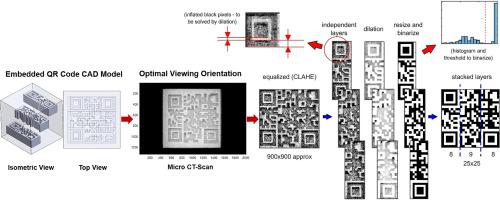Additive Manufacturing ( IF 11.0 ) Pub Date : 2020-05-24 , DOI: 10.1016/j.addma.2020.101319 Fei Chen 1 , Jaime Zabalza 2 , Paul Murray 2 , Stephen Marshall 2 , Jian Yu 3 , Nikhil Gupta 1

|
The layer-by-layer printing process of additive manufacturing methods provides new opportunities to embed identification codes inside parts during manufacture. These embedded codes can be used for product authentication and identification of counterfeits. The availability of reverse engineering tools has increased the risk of counterfeit part production and new authentication technologies such as the one proposed in this paper are required for many applications including aerospace components and medical implants and devices. The embedded codes are read by imaging techniques such as micro-computed tomography (micro-CT) scanners or radiography. The work presented in this paper is focused on developing methods that can improve the quality of the recovered micro-CT scanned code images such that they can be interpreted by standard code reader technology. Inherent low contrast and the presence of imaging artifacts are the main challenges that need to be addressed. Image processing methods are developed to address these challenges using titanium and aluminum alloy specimens containing embedded quick response (QR) codes. The proposed techniques for recovering the embedded codes are based on a combination of mathematical morphology and an innovative de-noising algorithm based on optimal image filtering techniques. The results show that the proposed methods are successful in making the codes scannable using readily available smartphone apps.
中文翻译:

在增材制造部件中嵌入产品认证代码:用于提高扫描能力的成像和图像处理
增材制造方法的逐层打印过程为在制造过程中将识别代码嵌入零件内部提供了新的机会。这些嵌入的代码可用于产品认证和假冒产品的识别。逆向工程工具的可用性增加了假冒零件生产的风险,许多应用(包括航空航天部件和医疗植入物和设备)都需要像本文中提出的新认证技术。嵌入的代码通过成像技术读取,例如微型计算机断层扫描 (micro-CT) 扫描仪或射线照相术。本文中介绍的工作重点是开发可以提高恢复的微 CT 扫描代码图像质量的方法,以便它们可以通过标准代码阅读器技术进行解释。固有的低对比度和成像伪影的存在是需要解决的主要挑战。图像处理方法的开发使用包含嵌入式快速响应 (QR) 代码的钛和铝合金样本来解决这些挑战。所提出的用于恢复嵌入代码的技术基于数学形态学和基于最佳图像滤波技术的创新去噪算法的组合。结果表明,所提出的方法成功地使代码可使用现成的智能手机应用程序进行扫描。固有的低对比度和成像伪影的存在是需要解决的主要挑战。图像处理方法的开发使用包含嵌入式快速响应 (QR) 代码的钛和铝合金样本来解决这些挑战。所提出的用于恢复嵌入代码的技术基于数学形态学和基于最佳图像滤波技术的创新去噪算法的组合。结果表明,所提出的方法成功地使代码可使用现成的智能手机应用程序进行扫描。固有的低对比度和成像伪影的存在是需要解决的主要挑战。图像处理方法的开发使用包含嵌入式快速响应 (QR) 代码的钛和铝合金样本来解决这些挑战。所提出的用于恢复嵌入代码的技术基于数学形态学和基于最佳图像滤波技术的创新去噪算法的组合。结果表明,所提出的方法成功地使代码可使用现成的智能手机应用程序进行扫描。所提出的用于恢复嵌入代码的技术基于数学形态学和基于最佳图像滤波技术的创新去噪算法的组合。结果表明,所提出的方法成功地使代码可使用现成的智能手机应用程序进行扫描。所提出的用于恢复嵌入代码的技术基于数学形态学和基于最佳图像滤波技术的创新去噪算法的组合。结果表明,所提出的方法成功地使代码可使用现成的智能手机应用程序进行扫描。



























 京公网安备 11010802027423号
京公网安备 11010802027423号